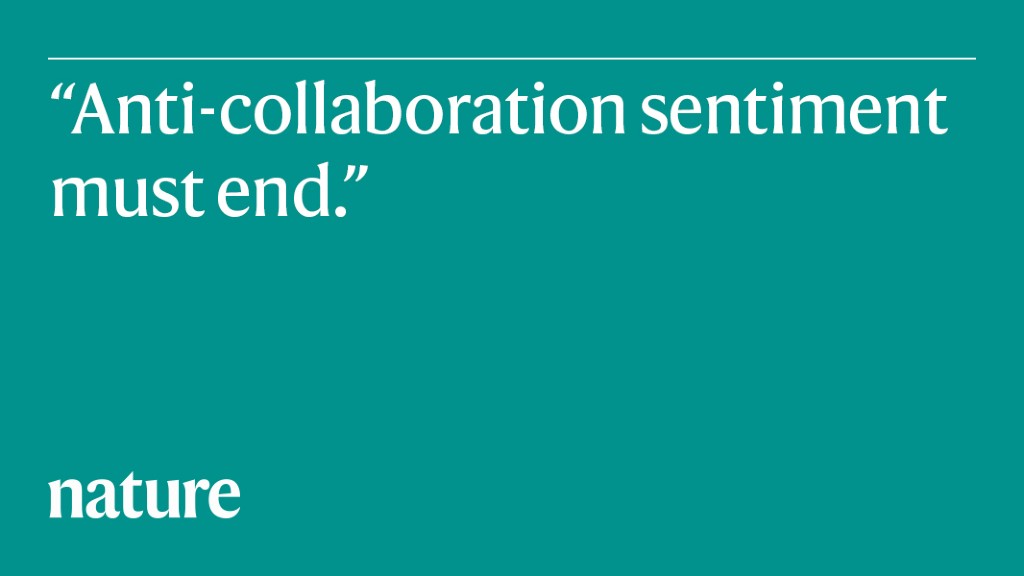WORLD VIEW 14 December 2021
During my first week at my new job in 2014, a senior colleague called me into his office to share experience and wisdom. He advised that if a research publication from my laboratory had foreign co-authors, then it would count little towards my career progression.I was taken aback. I was starting the position I had always aspired to — as an independent faculty member in my home country — but I certainly wanted to maintain the connections I had established during my studies overseas and to make new global ones. Having trained with three Nobel laureates, I knew the power of collaboration to drive cutting-edge science.I chalked up this advice as one person’s idiosyncratic opinion, and continued to nurture a broad network of international collaborators. This was crucial for my study of G-protein-coupled receptors, which pass diverse messages across the cell or nuclear surface and are the targets of powerful drugs, including those prescribed to treat heart failure, hypertension, allergies and mental illnesses.Today, the research in my lab is built on extensive connections across the globe. It has been recognized with several national awards, which I think reflects a growing appreciation of overseas collaborations. Dozens of students and early-career researchers whom I mentor see how working with scientists in other nations helps them to achieve greater insights and holistic understanding. I am incredibly proud of them. Reviewers are blinkered by bibliometrics Alas, I still often hear that the committees that evaluate promotions and awards look down on work that includes out-of-country collaborators. This idea has come up in casual conversations. Some senior scientists consider it essential advice, even writing it in e-mails. Their contention? If there is a foreign author on a paper, even in the middle of the list, then the paper has been published in a high-visibility outlet because of that author and not because of the science.I don’t want to cast assessment committees in a bad light. My aim is to raise an awareness of this bias, which might sometimes be unconscious. It runs counter to national strategy.In the past few years, India has invested heavily in huge science projects and international partnerships with institutions such as Wellcome, the London-based research funder, and the funding agency UK Research and Innovation, and the impact is starting to show. For example, the Mega Science Vision from the Indian government explicitly supports and promotes international collaborations. The Department of Science and Technology, a major funding agency in the country, has launched several bi- and multilateral collaborative funding schemes over the past few years. India has also joined with international research-funding bodies, such as the Human Frontier Science Program and the European Molecular Biology Organization.But junior colleagues still sometimes suffer because of this bias. One told me about an astonishing experience at an interview for a faculty position. A senior member of the hiring committee said he should not even have been invited because his research papers included foreign authors, and therefore it was too difficult to assess his contribution. This was a senior scientist entrusted with recruiting scientific leaders of the next generation.If it is possible to gauge the contribution of applicants from international institutes, then it is possible to evaluate a local or internal candidate’s work with foreign collaborators, especially with so many journals including an author-contributions section. This young, enthusiastic researcher was holding back tears. I felt that the system had failed him. Farewell authors, hello contributors In surveys during 2013 and 2015, taken by thousands of scientists from the United States, the United Kingdom, India, Italy, Taiwan, Hong Kong, Turkey and France, Indian scientists were the most likely to say that none of their scientific collaborators over the previous year had been from other countries (K. R. W. Matthews et al. Account. Res. 27, 477–495; 2020). Yet papers with international authorship tend to be more highly cited and impactful.I have personally seen the power of international collaborations to expand the quality of my research in India. Most labs and departments — even those in leading Indian research institutions — are relatively small, limiting the number of people available to work together on a project. For example, many crystallographers in foreign countries can simply drive to a synchrotron to collect X-ray diffraction data; in India, we have to plan several months in advance to send crystals and collect data at beamlines abroad. Moreover, one lab cannot acquire expertise in all possible methodologies to deal with a question, and sometimes technologies are available abroad before they can be accessed here: cryo-electron microscopy (cryo-EM) is an apt example.In 2018, a US$8.6-million (650-million-rupee) national cryo-EM facility opened in Bengaluru, after a cross-country lobbying effort. It was followed by four more such facilities, approved last year with a total cost of about $16 million. Now, protein structures can be studied using this powerful technique in the country. Still, collaborators across the world are crucial for support, including, for example, matching funds from Wellcome in an initiative called the India Alliance.Anti-collaboration sentiment must end. It undercuts scientists’ willingness to engage across borders. This limits their own work, and hampers the progress of science in India and globally. The author declares no competing interests.
https://www.nature.com/articles/d41586-021-03700-2
